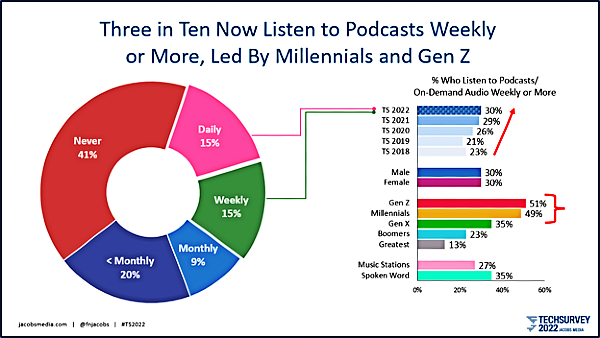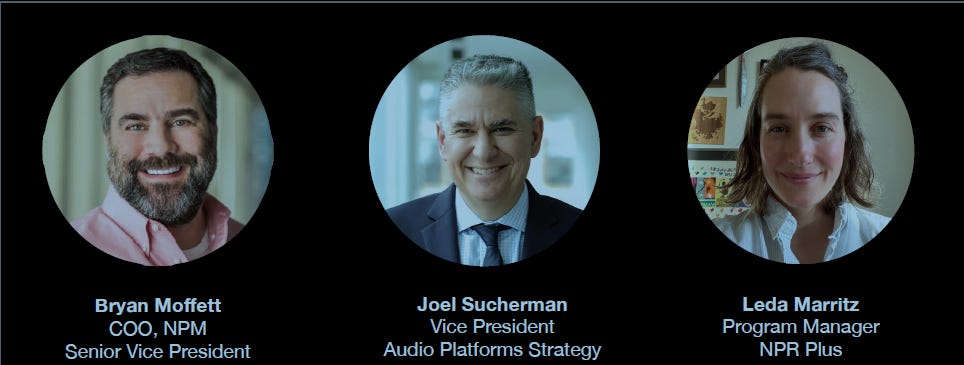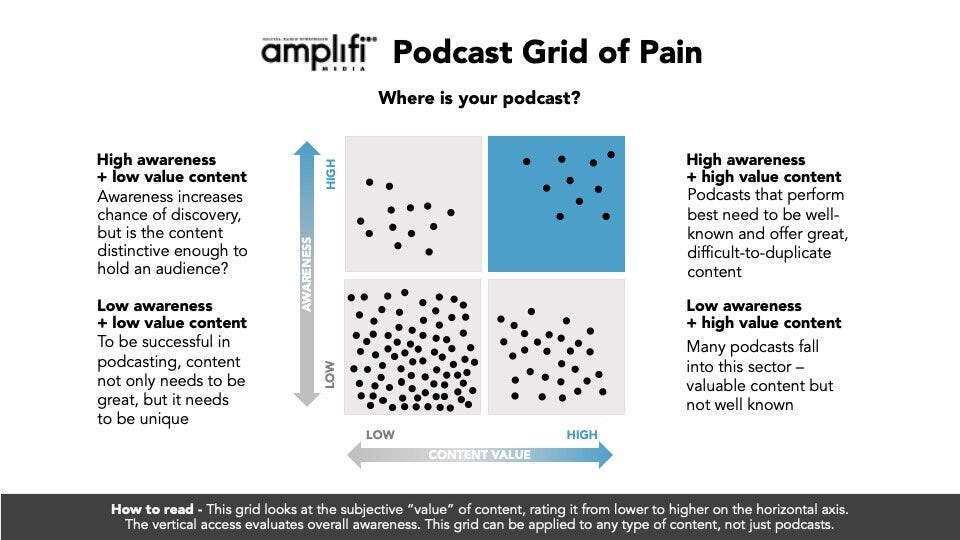Three Things for April 18, 2022
This week we preview the Jacobs Media TechSurvey 2022. Also, the first anniversary of Three Things, life stories, and next chapters.
First, an apology, I intended to write up a summary of last week’s Public Radio Super-Regional for this past Thursday’s Three Things. Unfortunately, travel issues in returning from Denver, and some technical problems, prohibited me from completing the post.
I’m hoping to have some thoughts written in the next week about this first in-person gathering for public radio folks since 2019, along with some ideas on a bold vision for public radio stations amid The New York Times strategy statement published last month.
Next, I want to urge you to check out an important post on Medium by public radio veteran Ken Mills. The post from last week takes a deep dive into the user accessibility of websites, specifically public radio websites, with some important observations for stations to take into consideration from the perspective of a person with low vision.
This piece is timely given that last month, as Mills notes, the U.S. Department of Justice released its first guidelines for website accessibility and Title III of the Americans with Disabilities Act (ADA).
I admire Ken for sharing his thoughts that come from his own experience as he’s explained publicly about the significant change in his life that occurred in July 2020 when his prescription eye drops caused a severe allergic reaction that resulted in losing over half of his visual acuity and two-thirds of his field of view.
I encourage you to check out the post and share it with colleagues.
THING ONE: The Jacobs Media TechSurvey 2022
One of the more enjoyable journeys that I’ve taken with the Three Things newsletter is to have the time to look at ideas and research from a bit of a different angle. One of those opportunities came last fall after the release of the Public Radio TechSurvey 2021 from Jacobs Media and PRPD.
In my post from the October 7, 2021 edition, I decided to compare and contrast the results of the tech survey of public radio listeners with the study done earlier in the year by Jacobs Media of commercial radio listeners. Most of the differences found in the two studies were pretty subtle:
Commercial radio listeners are much more frequent television users than public radio listeners, except when it comes to streaming video.
Public radio listeners are more likely to listen to podcasts regularly than commercial listeners (39% to 29%).
On the other hand, commercial radio listeners use smart speakers slightly more than public radio listeners (35% to 30%).
The same is true with the connected car (27% of commercial radio listeners have a connected car compared to 21% of public radio’s audience).
As the calendar turns, this week, the annual Jacobs Media TechSurvey 2022 goes public - a reminder that this is the commercial radio version - at the 2022 All Access Audio Summit.
This virtual event is this Wednesday, April 20, and Thursday, April 21, 2022.
The session featuring Jacobs Media President Fred Jacobs is on Thursday at 12:00 noon (Eastern).
Some results have been shared in a few promo teases for the session that might spark your interest in what has been learned this year.
The first is around podcast listening and reflects similar results from other research studies released this year, specifically The Infinite Dial from Edison Research.
As noted in the chart above, weekly podcast listening grew slightly in TechSurvey 2022 (30% this year compared to 29% in 2021).
However, there was a much more substantial YoY jump in podcast listening among the youngest listeners.
In the survey, weekly podcast listening among Gen Zs grew from 43% in 2021 to 51% in 2022. Other age demographics were flat or dropped in podcast listening from last year to this year. This is probably due to the world opening up more, given that other research has shown that most podcast listening happens at home1.
Some other great info about tech use coming out of the research is that “in-car media system ownership is reaching an all-new high in Techsurvey 2022. Now, three in ten drive a vehicle equipped with this feature.”
Sports format listeners lead the way, with news/talk listeners near the middle of the pack. One of the findings to watch this year is how this dashboard trend impacts AM/FM in-car listening. Last year’s survey found that listening fell to less than 50% for those with “Connected Cars.” I expect that downward trend to continue this year with more media options available in cars.
One of the important takeaways from last year’s TechSurvey was the growing concern about the number of subscription fees that survey respondents paid for media content. We should note that recurring members to public radio stations might see their sustaining memberships in public radio in much the same manner as a subscription to an audio or video service.
That concern has increased in 2022, with 68% of TechSurvey respondents now worried about the number of subscriptions they are paying for to get media content.
In a preview piece for the session in All Access, Fred Jacobs commented, “During the pandemic, consumers bulked up on video and audio streaming subscriptions. But this year, we’re seeing growing concern about how these fees are adding up when those credit card statements come rolling in.”
This concern was more significant for listeners to spoken word radio stations than music stations.
While concerns are increasing about streaming subscriptions, the trend also continued for consumers to “cut the cord on pay-TV.” Nearly a quarter of those who watch any TV/video programming on a typical weekday have stopped paying for cable or satellite television. This number is much higher for Gen Zs and Millennials, which does not bode well for the future if you’re a cable television operator. This also has enormous implications for local public television stations as younger audiences move to streaming as their first-choice option for watching TV.
The TechSurvey 2022 surveyed more than 30,000 listeners to more than 450 radio stations across North America. The surveys were completed this past January and February.
If you’re interested in registering for the All Access Audio Summit, you can see the full two-day schedule and sign up at this link.
If the plans follow what’s been done in previous years for the Public Radio TechSurvey 2022, registration will open in May, with the survey out in the field in late June and through July. Stay tuned to the Jacobs Media and PRPD websites in the coming weeks for more details.
THING TWO: Three Things at One Year
A year ago this week, I wrote my first Three Things newsletter post on Substack. I initially started with around 25 subscribers of public radio friends and colleagues.
One year later, the list to receive this newsletter is up to 625 subscribers, with an open rate for each edition at around 52 - 55%.
On this first anniversary, I thought it might be a good exercise to look back at a few posts from this past year with any worthwhile updates about those posts.
Over this past year, the most read post was the December 2, 2021 edition, where I expressed concerns regarding the state of the NPR - Member Station “network,” specifically regarding our digital platforms.
In the post, I shared some nuggets from the current NPR Strategic Plan that mentioned the goal and actions specific to the network as well as the KPIs for each strategic priority:
Realize The Power Of Local/National Network For An On-Demand Future
Leverage the network to shine a light on critical social issues across a diverse range of communities
Build a network-wide revenue model based on the passions of our audiences and the ways they connect with us
Align around a shared strategy for digital distribution and discovery that enables NPR and stations together to adapt to changing audience needs
Refocus the network so it can serve a wider variety of audiences and respond quickly to opportunities and threats
My concerns at the time questioned whether these actions and the KPIs that go with them were really what member stations were looking for through the local-national collaboration.
Since that post, there has been plenty of work taking place to better align NPR and stations toward a future where both can thrive. Among these activities has been the creation of a “Board Working Group” advisory committee that has the aspirations to profoundly change (meaning improve) the relationship between NPR and its member stations.
Last week at the Public Radio Super-Regional, members of the NPR Network Growth Team (Bryan Moffitt, Joel Sucherman, and Leda Marritz) shared some of the thinking going into the NPR+ podcast subscription service. In addition, some updated ideas were offered as to how to leverage local and national sponsorship to benefit stations.
I’ll have some further thoughts on these ideas coming up in Three Things, but I do want to note that NPR is presenting the first of three webinar options for member stations to learn more about the NPR Network this Wednesday, April 20, 2022, at 1:00 pm (Eastern).
The session is described by NPR as a renewed commitment to focus our local-national network to better serve our communities, reach new and more diverse audiences, and significantly grow audience support for public media. It is an answer to the critical questions of where public media will find new members and future audiences.
Members of the Advisory Board Working Group and NPR leaders will share more about the initiative, specific initiatives and how you and your teams can get involved.
Another widely read post with many comments was a special edition where I looked at the Impact of September 11 on Public Radio. Today, the lesson from that moment is a critical turning point for NPR in becoming the national institution it is today. Many audiences discovered public radio's depth and sensitive coverage for the first time.
A final post from this past year worth noting was from August 19, 2021, where I looked at the podcast “Grid of Pain,” offered some ideas to bridge the divide between the media and American conservative and right-leaning audiences and encouraged exploring the philanthropic opportunity with Gen X.
As it pertains to the “thing” on bridging the divide between the media and American conservative and right-leaning audiences, The Pluralism Network from Trusting News is launching the next phase of its work that includes some monetary stipends for participating news organizations. The deadline for priority applications is next Monday, April 25, 2022, and you can find out more information at this link.
THING THREE: Life Stories and Next Chapters
I’ve always admired the mission of StoryCorps in preserving and sharing “humanity’s stories in order to build connections between people and create a more just and compassionate world.”
If you’ve worked in public radio for any amount of time, I’m pretty sure that a StoryCorps conversation on a Friday morning has, at some point in time, brought tears as you’re commuting to work. The power of life stories combined with the human voice (and some excellent editing) has always been a recipe for captivating and powerful storytelling and a public radio hallmark.
Over the past two years, I’ve thought a lot about StoryCorps and how history will look upon the conversations that have taken place since COVID-19 has permanently changed our lives in one way or another.
On the subject of history, one of the most gratifying and helpful exercises that I’ve undertaken in the past eighteen months is to write my own life story. The task to chronicle my work and personal life provided a valuable perspective on my career path and the choices that have impacted me, my family, and those I’ve worked with over the years.
The person who encouraged me to write my life story would frequently joke with me because of the “depth” (as in length) of my narrative, but the extensive look back helped pull out some essential anecdotes that provide a necessary perspective of how I got from there to here.
Until I took the time to write this account of my life, I didn’t fully recognize how important the early days of my career were to who I am today. From my high school and college radio experience to the early days of being the first paid staffer of what became the NPR station in South Bend, Indiana, the imprint of that work has stayed with me. And it’s been enormously helpful in starting a one-person consulting business to recall what’s needed to do when it’s all up to you.
The other piece of the life story that has jumped out front and center is family, specifically my wife and three daughters. I learn things from these four women every single day. My wife has been an incredible champion for my daughters while I’ve been toiling away in the world of public radio.
So with this history with many chapters already written, I’m sharing with you the news that I’m moving into a new chapter beginning today as the Executive Director of the Special Education Foundation here in the St. Louis region.
The Special Education Foundation is a not-for-profit 501(c)(3) organization whose mission is to assist students with disabilities in St. Louis County in achieving success in ways not supported by tax dollars. The Foundation aims to empower students with disabilities by giving them the tools and opportunities they need to succeed.
This role fits well for me in many ways. As you may know, two of our adult daughters living with us are on the autism spectrum, and our oldest daughter is a special education teacher in Ohio. So this position with the Foundation will fit nicely into my passion for helping kids with similar disabilities.
In addition, I’ve always been a believer in the importance of public education, which included serving on a school board for a few years two decades ago. So this role in supporting the public education system is also significant for me.
So with this news, I don’t think it’s going to be possible to continue writing and publishing this newsletter on an ongoing basis. However, I plan at least one more edition that I mentioned at the beginning of this post.
I am eternally grateful to you if you’ve found some value from these posts over the past year. If I’ve provoked some new thinking or ideas, I’ve accomplished what I’ve set out to do.
As I set my course with this new role, I would love any support you might be able to provide with a donation to the Special Education Foundation. You can make a gift at this link.
Public Radio will always remain a love of mine, and I look forward to staying in touch with the countless friends I’ve made on this journey.
Thanks, and let’s stay in contact. My new email address is tim@sef-stl.org.
Edison Research’s Podcast Consumer Tracking Report found that 59% of podcast listening occurred at home in Q4 of 2021









Congrats on the new endeavor, Tim. I'll miss your perspective on public media and Three Things has been a must read (or in other words, incredibly helpful).